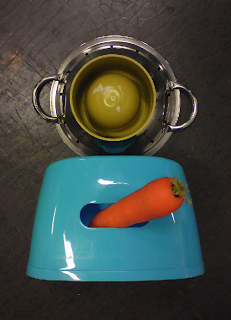
Jesse Wine, a fine art sculptor and 2nd year student at the RCA, gave a workshop yesterday on creating narrative using 3-dimensional objects. We looked at the photographed paper environments of Thomas Demand, Erwin Wurm's 1-minute sculptures (above), Tim Noble and Sue Webster's silhouettes and piles of rubbish, and Bruce Nauman's early post-college empty studio performances, not to mention Fischelli and Weiss' The Way Things Go:
(guilty secret: this is almost certainly the wrong thing to say, but I think we just about all agreed that we prefer the Honda advert version)
Another relevant artist, I think, would be Daniel Eatock. Despite a tendency toward bad visual puns, Eatock produces some thoughtful stuff. Works such as these sagging, and counter-balanced book shelves explore his interest in the intrinsic physical qualities of, and relationships between, everyday objects.
The session inspired me to look again at some other artists that were influential to me on my Fine Art BA, such as James Ireland, whose collections of "low" or "non-art" objects resemble something (usually landscapes) from a certain angle and if you squint a bit.

Another artist I took a lot from is Tom Friedman. In the tradition of the readymade, which began in 1917 with Marcel Duchamp's shop-bought urinal, entitled Fountain, Friedman explores the effect that isolating an object within the white space of a gallery has upon the viewer's perception of it. though instead of just presenting the objects as they are, Friedman looks at the fundamental characteristics of an object - What size is this? How does it fit together? - and assembles combinations that defy logic and patience, such as an infinite ring of plastic cups, or a pencil polygon.
I explored similar themes in my own work, by balancing either very large or very small objects, and having a go at replicating a modernist aesthetic with isotonic drinks pouches wedged between concrete slabs.
I remembered as a child baking crisp packets in the oven to shrink them, and tried the same thing with a plastic ruler, resulting in a 27cm-long ruler with 30cm markings just a little out. Another childhood trick - folding a banknote to make the Queen look like John McEnroe (well, it sort of worked...) - inspired a portrait of Charles Darwin as an neanderthal. (The portrait sadly didn't last long, as it was stolen from the wall of a Deptford gallery. Such appreciation!)


There's a fairly clear line between a lot of this stuff to advertising, though I think a lot of it may be coincidental, after all its only playing around with objects, not rocket science. Perhaps it's that disparity between the simplicity of production and the wow-look-at-that pay-off that makes these objects so appealing.
Here are two campaigns - for 42 Below Vodka by The Glue Society, and for Wallpaper Magazine - which use a virtually identical trick of stacking chairs into an arch:
And finally here are some images of the carrot-based sculptures that Ashley and I produced (with very limited materials) during the workshop, starting with a carrot-wasp:
 Carrot-henge:
Carrot-henge: Face with carrot-cigar:
Face with carrot-cigar: Carrot-wand-extender-thing:
Carrot-wand-extender-thing: And finally some kind of ropey-architectural model...
And finally some kind of ropey-architectural model...








No comments:
Post a Comment